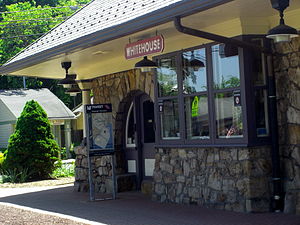White House | |||||||||||||
|---|---|---|---|---|---|---|---|---|---|---|---|---|---|
 White House station in March 2017. | |||||||||||||
| General information | |||||||||||||
| Location | 255 Main Street (CR 523), Whitehouse Station, New Jersey | ||||||||||||
| Owned by | New Jersey Transit | ||||||||||||
| Line(s) | Raritan Valley Line | ||||||||||||
| Distance | 44.3 miles (71.3 km) from Jersey City[1] | ||||||||||||
| Platforms | 1 side platform | ||||||||||||
| Tracks | 1 | ||||||||||||
| Construction | |||||||||||||
| Platform levels | 1 | ||||||||||||
| Parking | Yes | ||||||||||||
| Accessible | No | ||||||||||||
| Other information | |||||||||||||
| Fare zone | 19[2] | ||||||||||||
| History | |||||||||||||
| Opened | September 25, 1848[3] | ||||||||||||
| Rebuilt | 1892[4] | ||||||||||||
| Key dates | |||||||||||||
| December 9, 1891 | Station depot burned[5] | ||||||||||||
| Passengers | |||||||||||||
| 2012 | 110 (average weekday)[6] | ||||||||||||
| Services | |||||||||||||
| |||||||||||||
| |||||||||||||
White House Station | |||||||||||||
 | |||||||||||||
 | |||||||||||||
| Location | Main Street, Whitehouse Station, New Jersey | ||||||||||||
| Coordinates | 40°36′56″N 74°46′15″W / 40.61556°N 74.77083°W | ||||||||||||
| Area | 0.3 acres (0.1 ha) | ||||||||||||
| Built | 1892 | ||||||||||||
| Architect | Bradford Lee Gilbert | ||||||||||||
| Architectural style | Romanesque, Richardsonian Romanesque | ||||||||||||
| MPS | Operating Passenger Railroad Stations TR | ||||||||||||
| NRHP reference No. | 84002726[7] | ||||||||||||
| NJRHP No. | 1628[8] | ||||||||||||
| Significant dates | |||||||||||||
| Added to NRHP | June 22, 1984 | ||||||||||||
| Designated NJRHP | March 17, 1984 | ||||||||||||
White House is a NJ Transit railroad station on the Raritan Valley Line, in the Whitehouse Station section of Readington in Hunterdon County, New Jersey. The station is on the west side of Main Street in the center and the station building has subsequently been turned into a branch library for the Hunterdon County Library system. This station has no weekend service.
The building was designed for the Central Railroad of New Jersey in the Richardson Romanesque style by Bradford Gilbert who is best known for having designed the first steel-framed curtain wall building, but who also designed at least six railroad stations. It was added to the National Register of Historic Places in 1984 for its significance in architecture and part in the Operating Passenger Railroad Stations Thematic Resource.[7]
- ^ NJ Transit (2005). NJ Transit Rail Operations: Physical Characteristics. pp. 117–119, 142b, 173–182.
- ^ "Raritan Valley Line Timetables" (PDF). Newark, New Jersey: New Jersey Transit Rail Operations. November 7, 2010. Archived from the original (PDF) on November 7, 2016. Retrieved November 27, 2010.
- ^ "Original Route of New Jersey Central Railroad Followed Old Post Road Between Plainfield and Elizabethport, Historian Says". The Plainfield Courier-News. December 31, 1938. p. 7. Retrieved April 13, 2019 – via Newspapers.com.

- ^ Bernhart 2004, p. 69.
- ^ "A Railroad Station Burned Down". The Daily Times. New Brunswick, New Jersey. December 10, 1891. p. 1. Retrieved March 17, 2019 – via Newspapers.com.

- ^ "QUARTERLY RIDERSHIP TRENDS ANALYSIS" (PDF). New Jersey Transit. Archived (PDF) from the original on April 19, 2013. Retrieved December 31, 2012.
- ^ a b "National Register Information System – (#84002726)". National Register of Historic Places. National Park Service. March 13, 2009.
- ^ "New Jersey and National Registers of Historic Places – Hunterdon County" (PDF). New Jersey Department of Environmental Protection – Historic Preservation Office. December 28, 2020. p. 15.